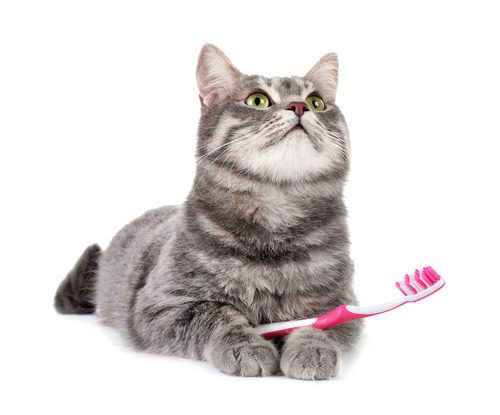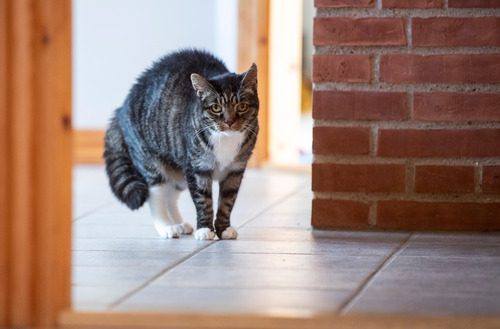Flea Bites on Cats: What to Look For and How Provide Your Pet Relief
Fleas are relentless little pests that can turn your cat’s world upside down with just a few bites. The discomfort and irritation they cause can quickly escalate, leaving your feline friend in a state of constant discomfort. Whether your cat is indoors or outdoors, these tiny intruders can find a way to disrupt their peace. If you’ve noticed your cat scratching or grooming excessively, it might be time to investigate. Don’t let fleas take control—reach out to any of our Heart + Paw locations or book an appointment online today to keep your cat comfortable and flea-free.

What Are the Signs of Flea Bites on a Cat?
Flea bites on a cat can be tricky to spot, especially if your cat has thick fur. However, there are some telltale signs you can look for that may indicate your cat has been bitten by fleas.
Visible Signs of Flea Bites
Flea bites often appear as small, red, raised bumps on your cat’s skin. These bites are usually found around the neck, lower back, and tail area. In some cases, you might notice tiny scabs where your cat has been scratching or biting at the bites.
Behavioral Changes
If your cat is unusually irritable, restless, or constantly grooming itself, these could be signs of flea bites. Cats are meticulous groomers, but excessive grooming—especially in concentrated areas—can be a response to the irritation caused by flea bites. Keep an eye out for excessive scratching, licking, or even hair loss in certain areas.
Presence of Flea Dirt
Flea dirt, or flea feces, is another sign of flea bites on a cat. Flea dirt looks like tiny black or dark brown specks on your cat’s skin or in its fur. If you’re unsure whether the specks are flea dirt, you can test by placing some of the specks on a wet paper towel. If they turn reddish-brown, it’s likely flea dirt, which indicates the presence of fleas on your cat.
How Flea Bites Affect Your Cat’s Health
Flea bites on a cat aren’t just itchy and uncomfortable; they can also lead to more serious health issues if left untreated.
- Allergic Reactions: Some cats are allergic to flea saliva, a condition known as flea allergy dermatitis (FAD). For these cats, even a single flea bite can cause intense itching, redness, and swelling. FAD can lead to significant discomfort and secondary infections if your cat scratches the bites too much.
- Anemia in Severe Cases: Fleas feed on your cat’s blood, and a large number of bites can result in a significant loss of blood. Symptoms of anemia include lethargy, pale gums, and in extreme cases, difficulty breathing.
- Transmission of Other Diseases: Flea bites on a cat can transmit tapeworms if your cat ingests a flea while grooming. Additionally, fleas can carry the bacteria that cause cat scratch fever, a condition that can be transmitted from cats to humans.
Steps to Provide Relief from Flea Bites on a Cat
If you suspect your cat is suffering from flea bites, here are some steps you can take to alleviate your cat’s discomfort.
Contact Heart + Paw
Flea bites on a cat can be managed effectively with the right treatment, but it’s necessary to get professional advice to avoid worsening the situation. Your Heart + Paw vet can recommend safe and effective flea treatments tailored to your cat’s needs.
Managing Itchiness and Irritation
Your vet may suggest topical treatments or medications to reduce itchiness and irritation caused by flea bites. These treatments can soothe your cat’s skin and help prevent secondary infections caused by excessive scratching. Always follow your vet’s instructions when applying any treatments to your cat.
Flea Control and Prevention
Your vet can recommend flea preventatives such as topical treatments, oral medications, or flea collars. Regularly treating your cat with a flea preventative can help protect them from future infestations.
Cleaning Your Home
Fleas can live in your home and reinfest your cat if you don’t take steps to eliminate them. Thoroughly vacuum carpets, rugs, and furniture where your cat spends time. Washing your cat’s bedding in hot water can also help remove fleas and their eggs. In some cases, you may need to use a flea spray or professional pest control service to fully eradicate fleas from your home.
What You Should Know About Long-Term Flea Control
Here’s what you need to know about keeping fleas at bay.
- Regular Veterinary Check-Ups: Routine wellness appointments with your vet can help monitor your cat for fleas and other health issues. During these visits, your vet can check for signs of fleas and recommend any adjustments to your cat’s flea prevention plan.
- Seasonal Considerations: Fleas are more active during warmer months, so you should be extra vigilant during spring and summer. However, indoor cats can still get fleas during the colder months, so year-round flea prevention is recommended.
- Integrated Flea Control: An integrated approach to flea control involves treating not just your cat but also your home and any other pets you have. By addressing all potential sources of fleas, you can significantly reduce the risk of re-infestation. This includes regular vacuuming, washing pet bedding, and using flea preventatives on all pets in your household.
Flea bites on a cat can cause discomfort and lead to more serious health issues, but with the right care and prevention, you can keep your cat happy and healthy all year long. If you suspect your cat has flea bites or want to discuss flea prevention, call any of our Heart + Paw locations or book an appointment online today. Our team is here to help ensure your cat lives a comfortable, flea-free life.
Recent Posts
Can Dogs Eat Ham?
Ham is a popular meat found on many dinner tables, especially during the holidays. As a dog…
8 Signs and Symptoms of Diabetes in Dogs
Caring for a dog means being tuned in to the subtle changes that can reveal their overall…
Why Dogs Can’t Eat Chocolate and Tips for Keeping This Sweet Treat Out of Their Reach
Chocolate is a beloved indulgence for us, but for our dogs, it’s a hidden danger that can…
Why Cat Teeth Cleaning is Important For Your Pet’s Health
As a cat owner, you know how important it is to care for your feline friend’s overall…
Cat Body Language: A Guide To Understand What Your Cat is Telling You
Imagine trying to communicate without words, relying solely on subtle gestures, glances, and movements. This is how…
About Us
Heart + Paw was founded in 2018 by Chief Veterinary Officer Dr. George Melillo, who currently serves the Mid-Atlantic area. Heart + Paw offers a combination of veterinary care, pet grooming, and dog daycare to help be a resource in your pet parenthood journey.
We'd Love to Meet Your Four-Legged Friends
Find out how the friendly veterinary team at your local Heart + Paw can help your pets live longer, healthier lives by searching for a location near you.





